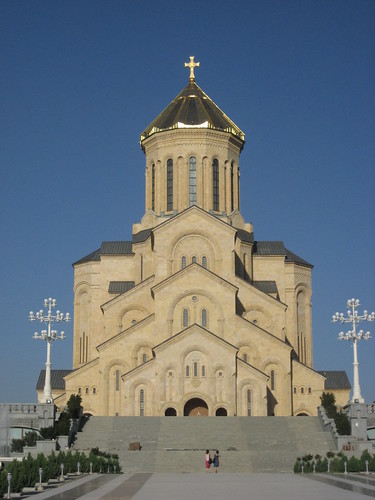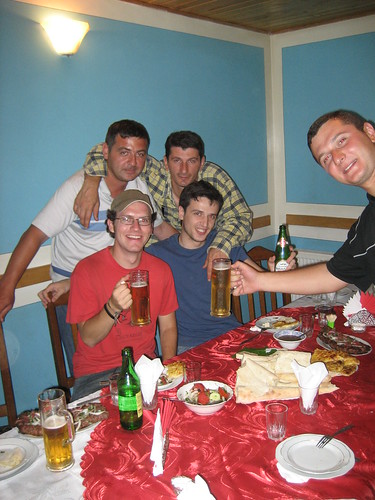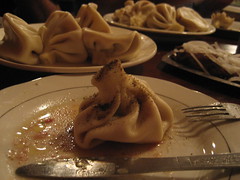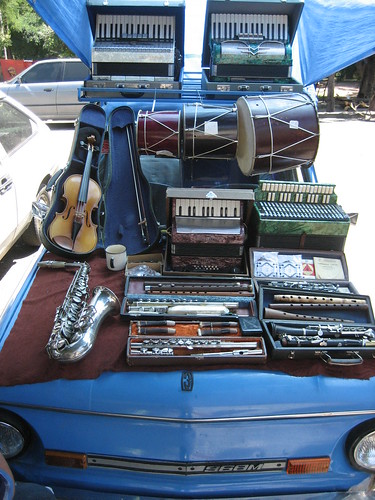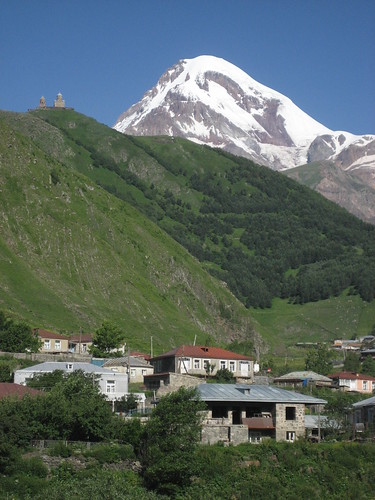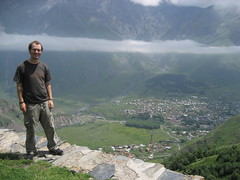This country does not exist
My loop through Turkey and Georgia brought me back to the intensity of Istanbul, where I met up with Matt Coyle, a good friend I've known since elementary school, who flew out to join me on the road for a couple of weeks.
Matt and I had a great couple of days touring around Istanbul, checking out the city's top-notch collection of historical sites. We spent some time under the gigantic tiled dome of the Blue Mosque, dropped in for a quick wander of the Grand Bazaar, visited a historic hammam bathhouse, and headed underground out of the sweltering heat into the Basilica Cistern. The cistern is a massive underground chamber of water, built in the 6th century during the reign of Roman Emperor Justinian. Through references in text, archaeologists knew of the cistern's existence, but they weren't sure exactly where to find it until they ran across a local villager who claimed to be able to catch fish from the comfort of his own home. The cistern was re-discovered, and now visitors can walk among more than 300 of the dramatically-lit columns that hold up the ceiling, including a few which are intricately carved. Matt and I both loved the experience.
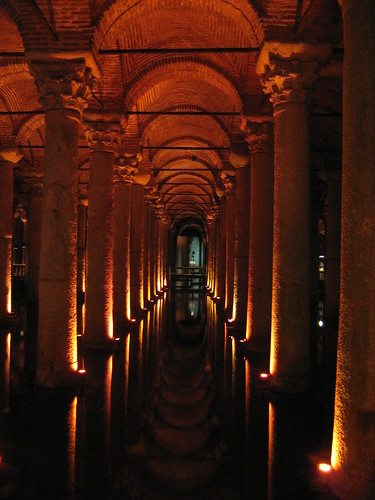
We also visited the remarkable Topkapi Palace complex, the massive former home of the numerous sultans who ran the Ottoman Empire for more than 400 years. Almost like the Forbidden City in Beijing, the palace has a nested courtyard design, and each of the four courtyards had specific rules about who was allowed to visit. The first was open for public events, and the fourth only for the sultan and special invited guests. We toured the Harem, a eunuch-guarded housing complex for the sultan's army of concubines. Interestingly, the sultan's mother — often a former-concubine — was given most of the control over the concubine girls, and controlled the sultan's choice of ladyfriends with a heavy hand. The rooms in the Harem ranged from the elaborately decorated so-called Queen Mother's chambers, down to the humble rooms for individual concubines. On display in the palace itself are hundreds of artifacts ranging from gifts to the Ottoman Empire from China and Japan, to gaudy gilded and diamond-encrusted trinkets commissioned by the Ottomans to adorn the burial place of the Prophet Mohammed in Medina. Shockingly, they even had the arm bones of St. John the Baptist.
After getting our fill of historic sites, we headed out into contemporary Istanbul, visiting the Istanbul Modern museum, which had a great collection of Turkish modern and contemporary art, as well as some special exhibitions by international artists. Our favorite were the spectacular wall-sized photographs by Andreas Gursky, an artist who skews reality into surreal scenes that have to be seen to be believed. Matt and I also strolled along the main street in the Taksim neighborhood, a massive all-night party where we stopped to get some dondurma, a gooey Turkish ice cream which was delivered to us in a acrobatic slapstick performance by the hilarious seller.

We left Istanbul on an overnight train to Veliko Tarnovo, a small Bulgarian town dominated by hilly terrain and a winding river. The town's setting is really incredible — the houses along the river tumble down the hill as if they were frozen in the middle of a landslide.
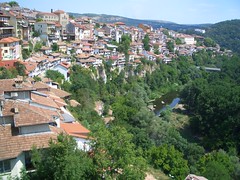
We spent a few days exploring the town using our great hostel as a base, checking out the quiet cobblestone lane that was once historic Veliko Tarnovo's main drag, where we popped in for a look at an old family mansion, now converted into a quaint folk museum. We also visited the awesome ramparts of the town's Tsarevets Fortress, built and fortified by several conquering empires between the 5th and 12th century. The crown of the great fortress is a church filled with beautifully haunting modern frescoes painted by a Bulgarian artist in 1985. When a tour bus comes through and forks over enough money, the town puts on a surprisingly cool sound-and-light show on the castle's walls, which we backpackers watched along with the locals without having to pay.
On our many trips out into the small town for some aimless wandering, we were easily distracted from the historical sights by the swarms of stunning women parading through town. I've never seen anything quite like it. We also enjoyed eating ludicrously cheap meals in the town's many restaurants, where I tried one of my all-time favorite culinary mis-translations, nervous meatballs. Bulgarian food is inexpensive and excellent, and comes laced with plenty of meat, cheese, and potatoes — things that I was seriously craving the previous month in Turkey. One of the most popular dishes is a hearty stew served in a clay pot:
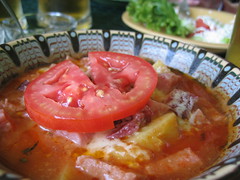
One of the strangest parts about Bulgaria is that the people nod their head to say "no" and shake their head to say "yes." It gets especially confusing at restaurants. You ask for a beer, the waitress indicates that this request is not possible, then returns with a big mug of beer. It's even more confusing with the nodding: you ask for beer, and the waitress nods to indicate that she'll be right back with your beer, then asks you to order something else. It was very strange. No, it wasn't. Wait, yes, it was.
We left Bulgaria and continued our journey northward across the border for a brief stop in Bucharest, the capital and largest city in Romania. On the traveler circuit, you don't often hear people describe Bucharest without somehow using the word "shithole" in their review of the town. As a result, we opted to tour Bucharest as a day trip. Along with our new Irish friend Tom, we had time to give the gritty town a wander, stop in for a look at the city's surprisingly good contemporary art museum, and take a tour of its massive Palace of the People. The monster of a building is the second largest on earth, only topped by the Pentagon in Washington, and is now used for government purposes, press conferences, and special events. The palace was commissioned by much-hated Communist leader Ceacescu, who carelessly leveled a historic neighborhood in order to build the gaudy palace, destroying two-dozen churches and synagogues and causing more than 70,000 people to become homeless in the process. One woman on our tour literally swooned with delight as we entered every decadent room, but for me, the building stands as a memorial to man's sad ability to occasionally bring completely idiotic ideas into reality.
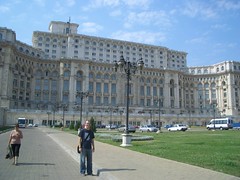
Our next stop was Brasov, a mid-sized town in the heart of Romania's fabled Transylvania region. We stayed with Irish Tom in a private apartment, which is a good alternative to a hostel if you've got enough people to split the costs. Like Veliko Tarnovo, Brasov is one of the up-and-coming towns in Europe, and feels like it's teetering on the edge of having a big boom in tourism. It's easy to see why — the town has an incredibly pleasant atmosphere, and it's pedestrian-friendly lanes lead to one of my favorite town squares in Europe.

Romania is one of the poorest countries in Europe, and when I visited back in 2003, I had a distinct impression that the country felt completely doomed. People had little hope of ever joining the European Union, and it seemed like everyone wanted to get out of town. I remember leaving Romania with the feeling that the country was like a sinking ship, with everyone scrambling to fend for themselves and get out of there.
What a difference four years makes. Now, with Romania as a partial member of the EU, there's a buzz in the air and the place feels really exciting. People now seem to realize that although their country is still fairly poor, they are rapidly on their way to a much higher quality of life than they had during the pre-1990s communist days. Seeing a group of people in a country become proud of where they live was one of the underlying highlights of this trip through Romania.
We took a day trip out across the Transylvanian countryside to the town of Bran in order to visit the famed 14th-century castle where Vlad Tepes — better known as Dracula — supposedly spent a few years of his life. The little rooms spread out within the bright and cheerful little castle definitely don't conjure up images of bloodthirsty vampires, but we had a nice time checking out its stripped-down little rooms and sun-lit courtyards. Down below the castle are hundreds of cheesy souvenir hawkers which make most people want to get out of town as soon as possible. We stuck around and took a hike out into the small farming community of Bran, and were happy to find quiet village life largely intact despite the tourist trap in town, and there were plenty of little cottages, grazing cows and sheep, sunflower fields, and rusty old cars plying the dirt roads.
Back in Brasov, we happened upon a great little Renaissance Fair going on in town, where it seemed like the whole town showed up to watch the jousting competitions and drink cheap beer. Matt and I met a couple of Romanian girls who we spent the night hanging out with at the festival along with their friends. When the festival's beer supply went dry, we headed into town to get some more, and I casually questioned one of my new Romanian friends about his age before I got us both beer. "I'm only sixteen," he admitted, "but don't worry, I'll just go in and buy it." Before I knew it, he was coming out the door, his arms filled with four 2.5 liter bottles of beer. Ten liters of beer at 16! God bless Romania.

We left Brasov headed for a small town nearby called Sigisoara, an awesome little place dominated by its medieval citadel, a miniature walled city. Within the citadel are a few towering churches, quiet little squares, and tons of old pastel-colored houses and cafes. The town oozed with charm, and reminded me a bit of an even smaller version of Cesky Krumlov in Czech Republic, which I visited a few months earlier with my parents. We explored the town's history museum which had a nice scale model of the town, a collection of truly frightening historic gynecological instruments that looked straight out of a medieval torture museum, and spectacular views from the clock-tower on the top floor.

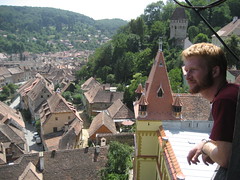
After a couple days soaking it all in, Matt and I left Sigisoara on a bus to Targu Mures, a nearby town served by WizzAir, one of Europe's newest in the group of no-frills low-cost airlines. Sadly, Matt had to fly back to the States in order to complete his National Guard service, so I was back on the road as a solo traveler. The two of us had a really great few weeks together on the road that I really only glossed over here — thanks Matt!
Somewhat randomly, there was an international music festival going on in Targu Mures, so I decided to postpone my planned journey to the country of Moldova and instead stick around town for the night. The festival was packed with Romanian and Hungarian kids who sang and headbanged along with their local rock bands. There were also a few international acts there too, and I caught an insanely fun performance by Gogol Bordello, a gypsy punk band of Eastern European immigrants now living in New York. The crowd was incredibly into it, and the whole place turned into a massive friendly mosh pit.
(video coming soon... maybe... these things are painfully difficult to upload. Here's one of them playing on TV in case you are desperately wondering what they sound like.)
Not having a place to stay, I wrongly assumed that the festival would not charge a camping fee, which they did. Since I didn't have a tent or a place to stay, I headed out into a field near the festival grounds and found a secluded spot where I could rest my head for the night. It was a freezing night spent curled up inside my waterproof backpack cover, but the upside is that it was free. And since I'm basically completely broke at this point, free is good.
The next morning, I dusted off the weeds, then spent a brutally long day traveling from Targu Mures near to a town near the Romanian-Moldovan border town of Iasi, where I arrived late at night. Shortly afterward, I caught the red eye train to Chisinau, the capital city of the poorest country in Europe and off-the-beaten-path traveling destination, Moldova. The only other travelers in my train were three hilarious Norwegian guys — Thomas, John-Erik and David — who provided some comic-relief from our dictator-like train attendant. We arrived in Chisinau and I was surprised both by the city's ultramodern train station, and by the guy awaiting my arrival with a placard bearing my name. Well, almost my name:
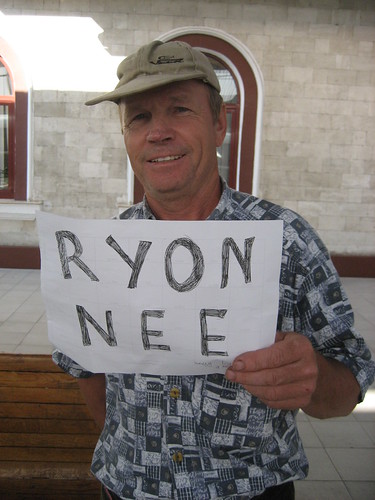
The Norwegian guys and I headed over to Marisha's apartment, one of the only budget accommodation options available in Chisinau. The place was filled with other budget travelers and had a really family-like atmosphere, and it was almost like a drama-free Eastern European version of the Real World. Something tells me Real World: Chisinau isn't ever going to make it onto the airwaves, and our massive soviet-era block apartment was definitely a far cry from the posh Real World house.
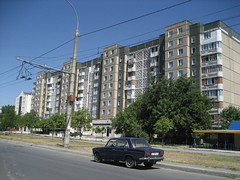
One of the Norwegian guys had a copy of the seventh and final Harry Potter book, which crippled any chance that I would sightsee in Chisinau, but I did reluctantly take a few breaks from the book to make a few day trips.
The first was to a country that does not exist: Transdniestr.
If you've never heard of it, that's because Transdniestr isn't officially a country, at least as far as most other nations are concerned. What the breakaway republic does have, however, is all the components of a country: its own government, flag, postal system, police, borders, and even its own currency, the Transdniestrian Rouble. It is also home to more than a half a million people. The bizarre country, formed as a long strip of land along the eastern side of Moldova, is doing its best to avoid outside influence, and clinging to the ideology of Lenin-era communism.
The major issue with trying to go to Transdniestr as a foreigner is just that — they don't want outside influence. Many foreigners who attempt to cross get turned back, or often heavily fined. Luckily, Marisha arranged her Russian-speaking friend Natasha to go along with us on a trip to Tiraspol, the country's capital city, which sits about an hour bus ride outside of Chisinau. At the intimidating border, the Norwegians and I handed over our passports to Natasha, who relayed them to the mass of border guards. She spent ten minutes arguing with the guards, as we tried to calm our nerves — word is that the guards especially dislike Scandinavians and Americans, so we had all the wrong bases covered. Natasha was able to talk our way in without paying the 30 Euro bribe they requested, but we were only allowed to spend three hours in the country, which was fine by me. We took a speedy tour of Tiraspol, which has the wide boulevards, awful soviet-era architecture, and massive public squares that you would expect in a Soviet city. It also has more than its fair share of monuments to soviet struggles, out-of-commission tanks, and statues of Lenin. It also had a noticeably heavier police presence than Chisinau, and Natasha had to yell at me at one point when I tried to photograph an off-limits government building. Despite all the communist influence, there were a few stores and restaurants open for business, and it seemed like time would eventually crumble the differences between Transdniestr and Moldova.
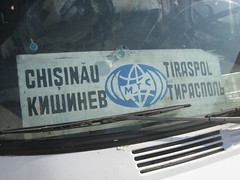
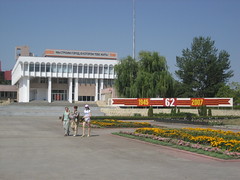
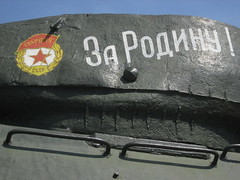
Our second day trip was out to a Cojusna Vineyard, one of Moldova's many, where we were given a tour of the long hallways of the dusty old cellars and the huge banquet-hall tasting rooms. Our cute guide showed us around and gave us her honest opinion on everything we saw: "This wall-hanging was woven by hand by a Moldovan villager over the course of eight years. I think it's really ugly." Thomas, John-Eric and I had our fill of the culinary smorgasboard and solid wine selection, which included a few whites, a few reds, a desert wine, and a port, some of which were bottles more than twenty years old. It was a really fun trip, and the underground cave-like tasting room made it a really memorable experience.
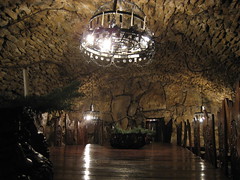
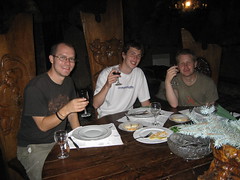
Chisinau itself was a town hit hard by a communist legacy, and lacked a nice old town district that most formerly-communist cities have. Chisinau feels like the very edge of Europe — still European if you squint and use your imagination, but it mostly feels burdened under the weight of communism. I spent a week living in Chisninau, mostly because it's among the cheapest places in Europe, but also because I was completely exhausted by traveling all the time, and having a home-base was just what I needed. After a relaxing week lounging around the apartment, I finally left Moldova headed for Kiev, Ukraine.
I climbed aboard the train and found my compartment with a bunch of shirtless and scruffy alcoholic men, who had scars that made them look like they had weathered one too many knife fights. At around 2:00 am, we passed through the Moldovan checkpoint and across the border with Ukraine. With one look at my passport, the stern green-uniformed border guard told me to follow him into the train corridor. "Bring your baggage," he added. On my 30-somethingth border crossing of the trip, this stood out as an unusual request, but I didn't have much choice but to follow him. My heart pounding, I grabbed my backpack and he led us into an empty train compartment, where he locked the door behind us. I tried to stay calm, but kept nervously glancing at the jet-black Kalishnakov assault rifle slung from his shoulder. He dug through my baggage for a few minutes, and told me to empty my pockets. He thoroughly patted me down, discovered and removed my moneybelt, and carefully flipped through its contents, apparently looking for cash. He spoke for the first time in ten minutes.
Him: "This isn't Moldova."
Me: "I know.... it's... Ukraine.... right?"
Him: "No, this is Transdniestria."
Holy shit.
Somehow a train I assumed would go directly north into Ukraine went instead southeast into Transdniestr. I knew I was seriously screwed, and I glanced over at my moneybelt to see how much cash I would be parting with in order to comply with the well-armed border guard representing a country that doesn't exist. Since I'm at the end of my trip and basically broke, all I had was 15 US Dollars and 20 British Pounds, the latter of which he stupidly passed up, not knowing they were worth more than double the US Dollars. Frustrated that he was trying to extort money out of the most broke dude on the train, he gave up, asked for my US cash as a "present," and thankfully let me get the hell out of there frightened, but unscathed.
Unfortunately, I'll have to leave you all stuck here on the border between Transdniestria and Ukraine, but I have come a long way since, and I'm now safe and sound in an internet cafe in Budapest. I'm headed west into Croatia tomorrow where my friend Gerni will re-join me for the final stretch of my trip, traveling through the former Yugoslavia.
With exactly a month until I return home, I have a packed schedule planned, and as a result, I might not be able to update the blog again before I return home. If that's the case, I really want to thank you all for reading this far — I'm almost there!
Ryan
